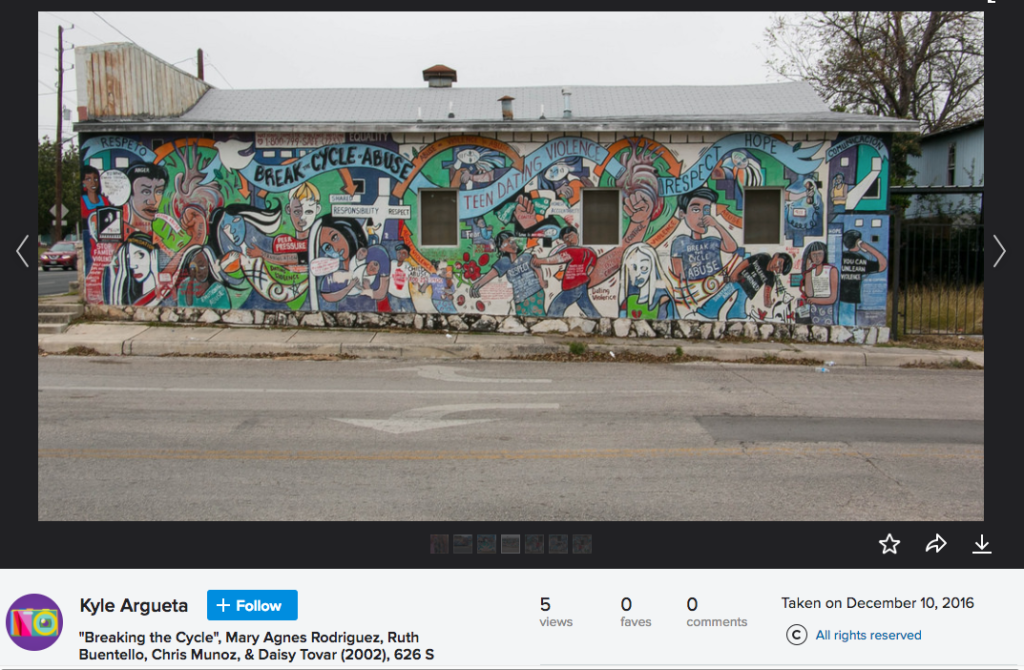
Captured are images of wall murals painted across San Antonio’s historic Westside neighborhood. The city’s Westside is a hotbed for Mexican-American culture and serves a predominantly Hispanic population. However, the area has been plagued by decades of rampant crime and violence, entrenched poverty, faltering education, and social injustice. Each mural creatively portrays a relevant issue the neighborhood struggles with, ranging from domestic abuse to unsatisfactory local education. These murals serve as a sobering reminders of the area’s troubling history, but also make a clear call to action for peace, love, and community engagement. Each mural is loaded with cultural signifiers and emotional appeals that propagate a carefully curated message which aims to evoke a particular response and influence the attitudes of spectators.
The interplay between art and propaganda generates a refreshing discussion on what the artist is trying to accomplish, while also analyzing the methods the artist takes during the creative process. Each piece is filled with images, quotes, and designs that work together to convey a clear message, leaving little room to question the artist’s intentions. I decided to stretch myself creatively by returning back to an old love: photography. The photography series is composed of 34 photos that explore 10 murals painted by local artists across the district. Placed together, these photos create a narrative of how the neighborhood addresses looming challenges, while also projecting messages that seek to persuade and influence residents to improve, both at the collective and individual level.
Elaborating on the characteristics of propaganda, French Philosopher Jacques Elluls writes about the foundational techniques used in effective propaganda[1]. One of the main characteristics of propaganda is considering the individual in terms of what he/she has in common with others (i.e. motivations, feelings, beliefs). This characteristic translates to the neighborhood ethos of staunch commitment to culture, tradition, and community. Moreover, the murals capture the neighborhood’s ethos and infuses it with a historical reflection on the neighborhood and a gentle head nod towards progress. Each mural artist has local roots, and understands that members, along with their stories, are the ties the bind the community. Therefore, the technique is to address and influence the individual when he/she is alone in the masses. While the murals are designed for the public, change is generated at the individual level, thereby reinforcing that the individual makes the decision to adopt the mural’s message and takes corrective action to ensure that the community is respected and cared for. The community is more than streets and houses, it the cornerstone of resident identity, culture, and tradition; all experienced by the community, but have a special significance for each individual.
Another propaganda technique are emotional appeals. Psychologists Anthony Pratankis and Elliot Aronson believe that emotional appeals are used to influence the way individuals think and operate[2]. While the murals point towards hope and progress, there are some murals that incorporate elements of fear. Pratankis and Elliot write that while fear appeals have different variations, their goal is evoke discomfort. As such, some murals make references to dark and unsettling images, such as guns, knives, and people experiencing pain, to generate discomfort and concern. However, these disconcerting images are paired with uplifting quotes to remind residents to be part of a productive solution to end the inequities the area faces. These quotes and one-liners reduce threat and discomfort, and the call to action is considered attainable.
This series only provides a snapshot of how Westside residents are working to address the vicious cycle of violence, poverty, and neighborhood isolation. There are additional methods in which residents and community stakeholders take in order to address problems besides murals. However, these murals serve a creative outlets to voice concern, influence others, and express solidarity.
[1] Ellul, J. (1973). Propaganda: The formation of men’s attitudes. The characteristics of propaganda. 1-32.
[2] Pratkanis, A. & Aronson, E. (1991). Emotional appeals. Age of Propaganda. New York: WH Freeman and Company. 162-165.